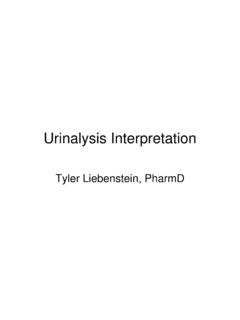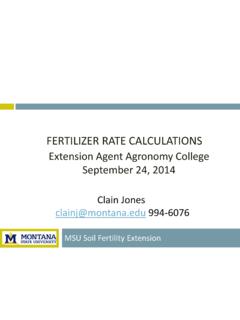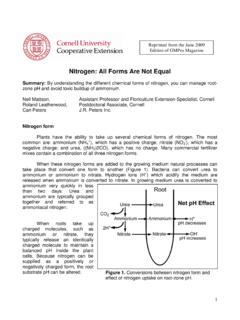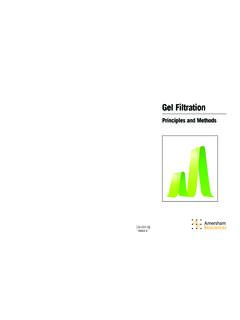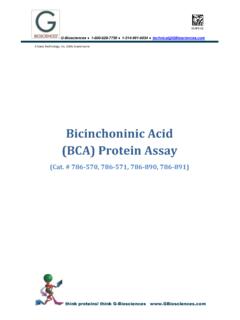Transcription of Principles of Renal Replacement Therapy
1 Principles of Renal Replacement Therapy Marie Pietruszka PharmD Senior Clinical Pharmacist University of Wisconsin Hospital and Clinics 2 Objectives Review Principles of chronic Renal Replacement Therapy Hemodialysis (HD) Peritoneal dialysis (PD) Discuss considerations for drug dosing with chronic Renal Replacement Therapy Review continuous Renal Replacement Therapy (CRRT) 3 Chronic Renal Replacement Therapy Hemodialysis (HD) defined by characteristics of dialyzer filter Conventional High Efficiency High Flux Peritoneal Dialysis (PD) 4 Goals of dialysis Replace diffusive functions of the kidney (solute removal) Replace convective functions of the kidney (remove excess free water) Dialysis cannot replace metabolic functions or hormone production Dialysis cannot perform active transport 5 Hemodialysis classification Intermittent Conventional or High Flux run 3-4 hours in length three times per week or more (common in the USA) Long intermittent dialysis runs over 8 hours three times per week Daily Short hours 6 to 7 days per week Home nocturnal hemodialysis: 8 hours overnight 6 to 7 days per week 6 Intermittent Hemodialysis System Components Dialysis machine Dialyzer membrane Dialysate solution Vascular Access Temporary Permanent (Fistula or Graft) The Blood Circuit - Hemodialysis 8 Blood Access is Primary!
2 Hemodialysis is not possible without access to very high blood flow rates (to allow >300ml/min through HD circuit) High flow access sites Temporary catheter in a high flow vein Permanent high-flow site surgically created 9 Temporary Vascular Access Temporary venous access: double lumen catheter (blood flows from patient through one lumen of the catheter into dialysis blood circuit and back through the second lumen into patient) Subclavian vein Femoral vein Internal jugular vein 10 Double Lumen Subclavian catheter 11 Gold Standard: Permanent Access Arteriovenous Fistula Arteriovenous Graft Radiocephalic AV Fistula 13 AV Fistula The fistula is created 2 to 6 months prior to initiation of dialysis The fistula matures over 2 months cannot be used before mature Connects the radial artery to the cephalic vein in the non-dominant arm The venous limb of the fistula dilates and thickens permitting repeated insertion of the dialysis needles three times weekly Lasts for years ( 3 yr fistula survival rate 65-75%) Blood flow is 1-2L/min(20-30% of cardiac output) can cause steal syndrome (distal ischemia).
3 14 AV fistula - mature 15 AV Fistula Cannulated for HD session 16 Poor Candidates for AV Fistula Morbidly obese Poor arterial flow (diabetes or severe atherosclerosis) Elderly Deep veins SOLUTION USE AN AV GRAFT! Common AV Grafts and Possible Complications Stenosis (narrowing) at the anastomotic site and thrombosis Infections (5-20% incidence) increased incidence if graft used before sufficient healing of the subcutaneous tunnel 19 Goals of Dialysis Attempt to normalize body chemistry and fluid status by removing uremic solutes and excess fluid. Although HD is twice as efficient in removing small molecules ( urea ) compared to functioning kidneys, it is only performed for 9-12 hours per week (overall less efficient). 20 Solute transport from plasma into the dialysate solution is accomplished primarily by diffusion (and to lesser extent convection). Removal of excess fluid accomplished by convection alone The pressure of the plasma within the capillary tubes of the filter is higher than dialysate solution surrounding the capillary tubes.
4 This forces free water and some solutes across the membrane and into the dialysis solution Physiologic Principles of Hemodialysis 21 Physiologic Principles of Hemodialysis Diffusion: solute clearance enhanced by blood flow running countercurrent to dialysate flow (maintains high concentration gradient between plasma and dialysate at all times) Ultrafiltration (convective transport) removes excess fluid volume ( ) due to the hydrostatic pressure gradient between the plasma and dialysate solution; solutes small enough to pass thru membrane pores are swept along with water (solvent drag). 22 Principles of Dialysis Diffusion-movement of solutes across the membrane K, BUN, phosphate, creatinine move from blood to dialysate solution Dialysate solution solutes can move into blood to a limited extent 23 The Dialysis Prescription The nephrologist prescribes the dialysis session: Length of session Goal ultrafiltrate removal (in kg) It is possible to perform dialysis without fluid removal Dialysate composition drives diffusion Calcium, potassium can be prescribed for the dialysate fluid 24 Dialysate solution (HD) Na+ 132-145 mEq/L No net transport.
5 Less than 135 mEq/L in dialysate associated with leg cramps and hypotension during HD K+ 0 4 mEq/L Net movement from blood into dialysate Cl- 103-110mEq/L No net transport HCO3- 0 40mEq/L buffer (Acetate) 2 37 buffer Ca++ 0 mEq/L Variable Mg++ 1 mEq/L Net movement from blood into dialysate Glucose 0 200mg/dL Prevent hypoglycemia 25 Example of Pre- and Post-Hemodialysis Lab Values Na+ 140 mEq/L (same pre and post) K- mEq/L ( mEq/L post) HCO3- 16 mEq/L (22 mEq/L post) pH ( post) BUN 100 mg/dL (40 mg/dL post) Serum Creatinine 6 mg/dL ( mg/dL post) 26 More than one type of Dialysis Hemodialysis Peritoneal Dialysis 27 28 Removal of solutes during Peritoneal Dialysis Diffusion is the principle mechanism by which peritoneal dialysis removes waste products and selected electrolytes ( urea , creatinine, potassium, magnesium, etc.) The concentration gradient between the dialysis solution and the capillary blood drives diffusion.
6 Maximum diffusion occurs when fresh dialysis fluid is first instilled in the peritoneal cavity but diffusion efficiency decreases over time. Frequent exchanges of dialysate solution (usually 4 -5 times per day) maintains diffusion efficiency. 29 Removal of fluids during Peritoneal Dialysis Ultrafiltration is the mechanism by which the bulk movement of water from the capillary blood moves across the peritoneal membrane into the PD dialysis solution in the peritoneal cavity. The osmotic pressure of the high glucose concentration in the PD dialysate solution draws water from the capillary blood supply into the dialysate solution (osmotic ultrafiltration). This differs from HD in which the hydrostatic pressure gradient is the driving force for ultrafltration during hemodialysis. Typical Peritoneal Dialysis Solution Dextrose Drives Osmotic Ultrafiltration ( = 2500mg/dL in PD fluid vs 100 mg/dL in plasma). Can add insulin to each PD bag if patient has persistent hyperglycemia.
7 Sodium 132 mEq/L No net diffusion of sodium Sodium Lactate 40mEq/L Buffer (cannot use bicarbonate in bag will precipitate as calcium carbonate) Magnesium mEq/L Net diffusion of Mg++ from blood into PD solution Calcium mEq/L Net diffusion of Ca++ into blood (not all PD dialysate bags have high Ca++ ) Chloride 96 mEq/L No net diffusion of chloride pH Low pH prevents carmelization of glucose during sterilization-may cause discomfort for the patient when new PD fluid instilled Peritoneal Dialysis CAPD vs cycler 32 Treatment of peritonitis during CAPD Antibiotics can be added to the PD dialysate solution to treat peritonitis (at home by patient or in hospital by RN) The concentration of the antibiotic in the PD fluid is similar to the concentration that could be achieved in the blood during IV antibiotic Therapy . Patients can initiate antibiotic treatment at home under the direction of the PD nurse . Example: adding cefazolin to each PD bag to obtain a concentration of 125 mg/L to treat gram positive cocci (Staphylococcus).
8 33 Continuous Renal Replacement Therapies (CRRT) Since CRRT is continuous, there is less fluctuation of volume status, solute concentration and acid-base balance overall. The major advantage of CRRT is the slower rate of solute or fluid removal per unit of time. Important for hemodynamically unstable patients in an ICU setting. CRRT better tolerated than intermittent HD since most complications related to intermittent HD are due to rapid loss of fluid and solutes 34 CRRT Continuous Renal Replacement Therapy Slow Continuous Ultrafiltration: SCUF Provides only ultrafiltration using conventional dialysis machines Continuous Hemofiltration CVVH: continuous venovenous hemofiltration CAVH: continuous arteriovenous hemofiltration Continuous hemodiafiltration combines continuous hemofiltration (convection) with continuous hemodialysis (diffusion) 35 Hemofiltration Hemofiltration (CVVH) used when primary goal is fluid removal in patients with need to remove some small solutes.
9 Removes fluids and solutes by convection only the efficiency of solute removal is low. Requires the removal of 10-15L of ultrafiltrate per day to remove sufficient solutes. Must replace excess fluid loss by giving a balanced electrolyte solution as Replacement fluid No dialysis solution involved in process (no diffusion). CVVH vs. iHD CVVH Intermittent HD Blood Flow rate 100-150 ml/min 250-450 ml/min Solute removal Convection Diffusion Pharmacy orders Large amount of fluid Replacement bags supplied by pharmacy NA Technical complexity Technically less difficult but higher workload (24 hours/day) Technically more demanding but lower workload (2-8 hours/day) Cost 3 to 5 x more expensive than iHD Relatively inexpensive 37 Drug Dosing with Renal Replacement Therapy Clinical Pearls Recommendations for drug dosing must be based on type of Renal Replacement Therapy used ( HD, PD, CRRT) Drugs removed by hi-flux HD may not be removed by conventional filter HD Peritoneal dialysis can remove drugs not removed by conventional and high flux HD Distinguish between patients on Renal Replacement Therapy vs.
10 Renal insufficiency without Renal Replacement . Only knowing serum creatinine (or calculated CrCl) is NOT sufficient information. Hemodialysis clears creatinine using a calculated CrCL for dosing is incorrect for HD patients must use HD specific dosing recommendations. 38 Drug Dosing with Renal Replacement Therapy Clinical Pearls Calculation of Creatinine Clearance is not appropriate for HD patients. HD clears creatinine temporarily, so calculated Creatinine Clearance only reflects one point in time and may be misleading if calculated shortly after a HD session. Vancomycin example Calculated CrCl after HD session = 30ml/min; if pharmacist not aware patient is on HD, would dose as 10mg/kg every 24 hours Appropriate dosing for HD is 10-15mg/kg after each HD session ( 3 x per week if chronic HD) or after each HD session if on as needed HD for AKI 39 Transition from CRRT to iHD Critically ill patients with acute Renal failure may require CRRT in the ICU setting.
